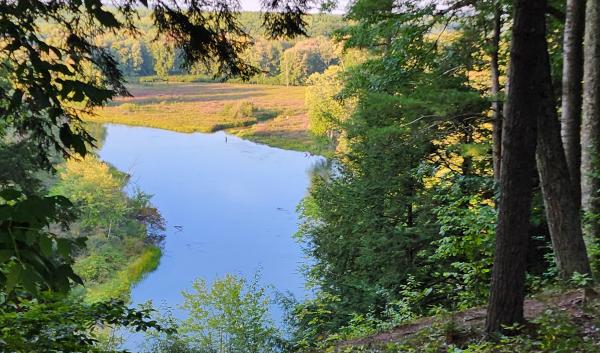This assessment provides scientific information on climate change and forest ecosystem conditions in northern Michigan. The main goal of this assessment is to provide forest managers, as well as other people who study, recreate, and live in the region, with information on factors influencing forest ecosystem vulnerability under future climate conditions.
The forests in northern Michigan will be affected directly and indirectly by the changing climate during the 21st century. Maintaining healthy forest ecosystems requires understanding the factors that could potentially impact forests, under future climate conditions.
This assessment evaluates the vulnerability of forest ecosystems in the eastern Upper Peninsula and northern Lower Peninsula of Michigan under a range of future climate scenarios. The assessment summarizes current conditions, key stressors, and identifies past and projected trends in climate. This information was used to create multiple vegetation impact models, which provided a range of potential vegetative responses to climate. Assessment of forest vulnerabilities was conducted with assistance and input from multiple scientists and forest management experts familiar with the region, using a formal consensus-based elicitation process.
The information below is a summary of each chapter available in the vulnerability assessment. For more information and in-depth discussion please refer to the full report. This chapter describes the major forest communities across Albert’s Ecological Sections VII and VIII and summarizes current threats and management trends. This information lays the foundation for understanding how shifts in climate may contribute to changes in forests, and how climate may interact with other stressors on the landscape. More than 70 percent of the forest land in Michigan occurs within the assessment area, most of which is owned by private landowners. This chapter provides a brief background on climate change science, models that simulate future climate change, and models that project the effects of climate change on tree species and forest communities. This chapter also describes the climate data used in this assessment. This chapter summarizes our understanding of observed changes and climate trends in the assessment area and across the Midwest region, with a focus on the last century. This chapter examines how climate may change in the assessment area over the next century, according to a range of model projections. Published scientific literature provides the basis for describing possible trends in a range of climate-driven processes, such as extreme weather events and snowfall. This chapter summarizes the potential impacts of climate change on forests in northern Michigan, drawing on information from a coordinated series of model simulations and published research. This chapter focuses on the vulnerability of major forest systems in the assessment area to climate change, with an emphasis on shifts in dominant species, system drivers, and stressors. The adaptive capacity of forest systems was also examined as a key component of overall vulnerability. Synthesis statements are provided to capture general trends. Detailed vulnerability determinations are also provided for nine major forest systems. We consider a system to be vulnerable if it is at risk of a composition change leading to a new identity, or if the system is anticipated to suffer substantial declines in health or productivity. This chapter summarizes the implications of potential climate change to forest management and planning in northern Michigan. This chapter does not make recommendations as to how management should be adjusted to cope with these impacts, because impacts and responses will vary across forest types, ownerships, management objectives, and site-specific conditions. Handler, Stephen; Duveneck, Matthew J.; Iverson, Louis; Peters, Emily; Scheller, Robert M.; Wythers, Kirk R.; Brandt, Leslie; Butler, Patricia; Janowiak, Maria; Shannon, P. Danielle; Swanston, Chris; Eagle, Amy Clark; Cohen, Joshua G.; Corner, Rich; Reich, Peter B.; Baker, Tim; Chhin, Sophan; Clark, Eric; Fehringer, David; Fosgitt, Jon; Gries, James; Hall, Christine; Hall, Kimberly R.; Heyd, Robert; Hoving, Christopher L.; Ib ez, Ines; Kuhr, Don; Matthews, Stephen; Muladore, Jennifer; Nadelhoffer, Knute; Neumann, David; Peters, Matthew; Prasad, Anantha; Sands, Matt; Swaty, Randy; Wonch, Leiloni; Daley, Jad; Davenport, Mae; Emery, Marla R.; Johnson, Gary; Johnson, Lucinda; Neitzel, David; Rissman, Adena; Rittenhouse, Chadwick; Ziel, Robert. 2014. Michigan forest ecosystem vulnerability assessment and synthesis: a report from the Northwoods Climate Change Response Framework project. Gen. Tech. Rep. NRS-129. Newtown Square, PA: U.S. Department of Agriculture, Forest Service, Northern Research Station. 229 p.. https://doi.org/10.2737/NRS-GTR-129
Major Findings
Download the Full Assessment
Download The Summary (4p)
Download The Field Guide
Details Of The Vulnerability Assessment
Potential impacts of climate change on ecosystem drivers and stressors
Potential impacts of climate change on forest communities
Adaptive capacity factors
How To Cite This Report
-
Climate Change Projections for Individual Tree Species
Browse climate change projections for individual tree species.
-
Northern Forests Vulnerability
Forests of the Midwest and Northeast significantly define the character, culture, and economy of this large region but face an uncertain future as the…
-
Climate Change Field Guides
The Climate Change Field Guides are designed to put useful climate change and adaptation information into the hands of natural resource professionals as they…



